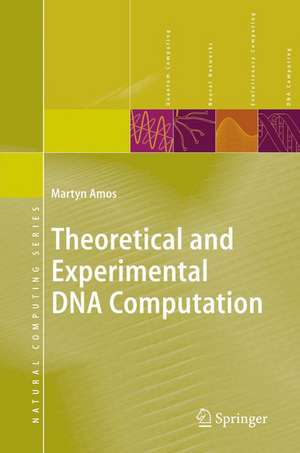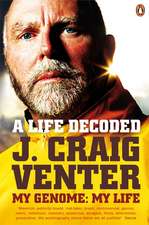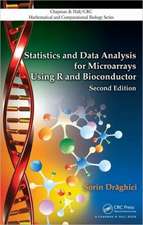Theoretical and Experimental DNA Computation: Natural Computing Series
Autor Martyn Amosen Limba Engleză Hardback – 23 iun 2005
| Toate formatele și edițiile | Preț | Express |
|---|---|---|
| Paperback (1) | 629.56 lei 6-8 săpt. | |
| Springer Berlin, Heidelberg – 21 oct 2010 | 629.56 lei 6-8 săpt. | |
| Hardback (1) | 639.90 lei 6-8 săpt. | |
| Springer Berlin, Heidelberg – 23 iun 2005 | 639.90 lei 6-8 săpt. |
Din seria Natural Computing Series
- 20%
 Preț: 507.37 lei
Preț: 507.37 lei - 20%
 Preț: 305.90 lei
Preț: 305.90 lei - 20%
 Preț: 992.26 lei
Preț: 992.26 lei - 20%
 Preț: 617.13 lei
Preț: 617.13 lei - 20%
 Preț: 645.47 lei
Preț: 645.47 lei - 20%
 Preț: 642.65 lei
Preț: 642.65 lei - 20%
 Preț: 998.04 lei
Preț: 998.04 lei - 18%
 Preț: 963.60 lei
Preț: 963.60 lei - 20%
 Preț: 655.20 lei
Preț: 655.20 lei - 20%
 Preț: 615.69 lei
Preț: 615.69 lei - 20%
 Preț: 645.65 lei
Preț: 645.65 lei - 20%
 Preț: 640.19 lei
Preț: 640.19 lei - 20%
 Preț: 655.02 lei
Preț: 655.02 lei -
 Preț: 384.70 lei
Preț: 384.70 lei - 20%
 Preț: 652.54 lei
Preț: 652.54 lei - 20%
 Preț: 649.28 lei
Preț: 649.28 lei - 20%
 Preț: 330.75 lei
Preț: 330.75 lei - 20%
 Preț: 328.09 lei
Preț: 328.09 lei -
 Preț: 389.70 lei
Preț: 389.70 lei - 20%
 Preț: 644.66 lei
Preț: 644.66 lei - 20%
 Preț: 333.88 lei
Preț: 333.88 lei - 20%
 Preț: 1299.31 lei
Preț: 1299.31 lei - 20%
 Preț: 528.47 lei
Preț: 528.47 lei - 20%
 Preț: 648.11 lei
Preț: 648.11 lei - 20%
 Preț: 322.43 lei
Preț: 322.43 lei - 20%
 Preț: 657.83 lei
Preț: 657.83 lei - 20%
 Preț: 659.31 lei
Preț: 659.31 lei - 20%
 Preț: 997.56 lei
Preț: 997.56 lei - 20%
 Preț: 508.61 lei
Preț: 508.61 lei -
 Preț: 400.85 lei
Preț: 400.85 lei - 20%
 Preț: 653.38 lei
Preț: 653.38 lei - 20%
 Preț: 308.60 lei
Preț: 308.60 lei - 20%
 Preț: 654.05 lei
Preț: 654.05 lei - 15%
 Preț: 652.17 lei
Preț: 652.17 lei - 20%
 Preț: 336.54 lei
Preț: 336.54 lei - 20%
 Preț: 656.19 lei
Preț: 656.19 lei
Preț: 639.90 lei
Preț vechi: 752.83 lei
-15% Nou
Puncte Express: 960
Preț estimativ în valută:
122.45€ • 126.32$ • 102.18£
122.45€ • 126.32$ • 102.18£
Carte tipărită la comandă
Livrare economică 27 martie-10 aprilie
Preluare comenzi: 021 569.72.76
Specificații
ISBN-13: 9783540657736
ISBN-10: 3540657738
Pagini: 185
Ilustrații: XIII, 173 p.
Dimensiuni: 155 x 235 x 17 mm
Greutate: 0.4 kg
Ediția:2005
Editura: Springer Berlin, Heidelberg
Colecția Springer
Seria Natural Computing Series
Locul publicării:Berlin, Heidelberg, Germany
ISBN-10: 3540657738
Pagini: 185
Ilustrații: XIII, 173 p.
Dimensiuni: 155 x 235 x 17 mm
Greutate: 0.4 kg
Ediția:2005
Editura: Springer Berlin, Heidelberg
Colecția Springer
Seria Natural Computing Series
Locul publicării:Berlin, Heidelberg, Germany
Public țintă
ResearchCuprins
DNA: The Molecule of Life.- Theoretical Computer Science: A Primer.- Models of Molecular Computation.- Complexity Issues.- Physical Implementations.- Cellular Computing.
Recenzii
From the reviews:
"Biomolecular computing, also known as DNA computing, has been a subject of research and scientific conversations for little over a decade. … Amos has made an effort to bring … the book closer to both theoreticians and the experimentalists. … I found Amos’s writing style very forthcoming, clear and friendly. It was a pleasure to read the book. … Any graduate student or a researcher without prior knowledge about biomolecular computing … will find this book informative, and a great introduction to the subject." (Nataša Jonoska, Genetic Programming and Evolvable Machines, Vol. 7, 2006)
"Amos describes the major theoretical models in common usage, and reports on the experimental implementations thereof. … the value of this book is twofold. First, it serves as a good primer on this emerging field for the novice reader. Second, it provides an account of the author’s contributions to the field … . I would recommend the book to researchers in the field, and to graduate students … as well as to those readers who are simply interested in the topic." (John Fulcher, Computing Reviews, April, 2006)
"The book is an overview of DNA computing. It touches both theoretical and experimental aspects. … The book is a good introduction to DNA computing for both new researchers, and readers having general interests." (Maulik S. Dave, SIGACT News, Vol. 39 (2), 2008)
"Biomolecular computing, also known as DNA computing, has been a subject of research and scientific conversations for little over a decade. … Amos has made an effort to bring … the book closer to both theoreticians and the experimentalists. … I found Amos’s writing style very forthcoming, clear and friendly. It was a pleasure to read the book. … Any graduate student or a researcher without prior knowledge about biomolecular computing … will find this book informative, and a great introduction to the subject." (Nataša Jonoska, Genetic Programming and Evolvable Machines, Vol. 7, 2006)
"Amos describes the major theoretical models in common usage, and reports on the experimental implementations thereof. … the value of this book is twofold. First, it serves as a good primer on this emerging field for the novice reader. Second, it provides an account of the author’s contributions to the field … . I would recommend the book to researchers in the field, and to graduate students … as well as to those readers who are simply interested in the topic." (John Fulcher, Computing Reviews, April, 2006)
"The book is an overview of DNA computing. It touches both theoretical and experimental aspects. … The book is a good introduction to DNA computing for both new researchers, and readers having general interests." (Maulik S. Dave, SIGACT News, Vol. 39 (2), 2008)
Textul de pe ultima copertă
This book provides a broad overview of the entire field of DNA computation, tracing its history and development. It contains detailed descriptions of all major theoretical models and experimental results to date, which are lacking in existing texts, and discusses potential future developments. This book will provide a useful reference source for researchers and students, as well as an accessible introduction for people new to the field.
The field of DNA computation has flourished since the publication of Adleman's seminal article, in which he demonstrated for the first time how a computation may be performed at a molecular level by performing standard operations on a tube of DNA strands. Since Adleman's original experiment, interest in DNA computing has increased dramatically. This monograph provides a detailed survey of the field, before describing recent theoretical and experimental developments. It concludes by outlining the challenges faced by researchers in the field and suggests possible future directions.
The field of DNA computation has flourished since the publication of Adleman's seminal article, in which he demonstrated for the first time how a computation may be performed at a molecular level by performing standard operations on a tube of DNA strands. Since Adleman's original experiment, interest in DNA computing has increased dramatically. This monograph provides a detailed survey of the field, before describing recent theoretical and experimental developments. It concludes by outlining the challenges faced by researchers in the field and suggests possible future directions.
Caracteristici
A detailed survey of the entire field of DNA computation Describes recent theoretical and experimental developments Outlines the challenges faced by researchers in the field Suggests possible future directions Includes supplementary material: sn.pub/extras













